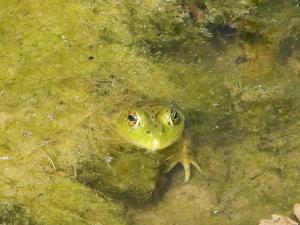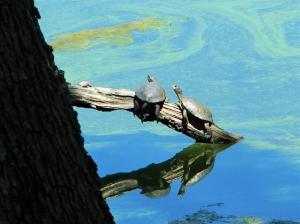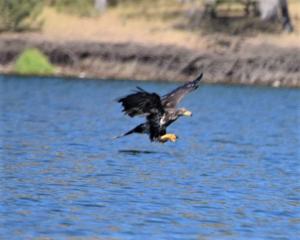Texas Blue Green Algae Versus Klamath Lake Blue Green Algae

Nitrogen fixing algae, as seen in Copco & Iron Gate Lakes on the Klamath River are Nature's remediating solution for anthropogenic nitrates in the water. They take nitrates out of solution and integrate them into their bodies, thereby sequestering nitrates

Copco Lake was created over the existing 'Clammittee Lake', that existed for millennia. The myriad of species of flora and fauna in and around the critical habitat provided by the fresh water ecosystem of the lake is amazing. Photo: William E. Simpson II

A pair of threatened Western Pond Turtles at Copco Lake. Just one of many threatened and endangered species of flora and fauna thriving in or around Copco and Iron Gate Lakes. Photo: William E. Simpson II

Bald and Golden Eagles, as well as the many other raptors at Copco and Iron Gate Lakes on the Klamath River, prefer nest boxes and trees at the lakeshore, which provides access to fish and other prey on and around the lake.

A Golden Eagle is seen fishing on Copco Lake. There 19-species of raptors, many of which consume fish all summer long. There are no documented cases of algae toxicity illness or deaths in raptor populations at Iron Gate or Copco Lakes.
The Klamath River dams that created Copco and Iron Gate Lakes provide habitat required by nitrogen-fixing algae that reduce nitrate pollution in Klamath River
In the history of Copco and Iron Gate Lakes, empirical evidence proves no widespread fish or wildlife kill-off related to the blue-green algae. In fact, some animals eat the dried algae (See Video)"
— William E. Simpson II - Naturalist
YREKA, CALIFORNIA, UNITED STATES, July 24, 2021 /EINPresswire.com/ -- Klamath River dam removal activists, who are merely minority-consensus fishing-zealots, fail in their understanding of the value proposition of the naturally-occurring blue-green algae (Microcystis aeruginosa).
In an effort to pitch any plausible reason for removing the Klamath River dams, dam-removal activists condemn the blue-green algae in an attempt to support a flawed argument for the removal of the dams on the Klamath River below the Klamath basin.
One of the fishing-zealot mantras has been that the dams are a problem because they create 'toxic' algae blooms that are seen in late summer on the lakes, specifically, Iron Gate and Copco lakes.
This hypothesis is contrary to empirical evidence, as well as published peer-reviewed science.
The impact of the toxicity of the blue-green algae on the fish and wildlife is greatly exaggerated by the dam-removal zealots.
If the algae had the toxic impact, that is seriously overstated by dam-removal, there would be obvious fish and wildlife kill-offs!
Such kill-offs have never been documented, and you can bet, these zealots would have paraded any genuine evidence of any such events if they had occurred at Copco or Iron Gate Lakes.
EMPIRICAL EVIDENCE
People from Siskiyou County California, Jackson County California and elsewhere have been catching the fish in Copco and Iron Gate Lakes virtually year-round and consuming them for decades. There are no documented cases of algae-related illness or deaths in humans associated to the algae in these Copco or Iron Gate Lakes on the Klamath River.
No widespread fish or wildlife kill-off has ever been documented at Copco or Iron Gate Lakes.
There are 19-species of raptors that have habitat in the immediate vicinity of Iron Gate and Copco Lakes, many of which consume the fish from these lakes in the summer (height of algae bloom) on a daily basis, over the past 6-decades.
No raptors (Bald and Golden Eagles, Ospreys, etc.) have been found dead or dying from algae toxicity.
Wild horses that have lived in the area for millennia (there are horse fossils in the area) and which have been consuming the dried algae from the lakes over many decades have never suffered any ill-effects.
(THIS VIDEO, taken by naturalist and wild horse expert, William E. Simpson II shows a band of wild horses grazing dried strands of algae on the shore of Iron Gate Lake on July 22, 2021: https://youtu.be/dhhJv8tP0qQ )
THE SCIENCE:
The specific algae that is observed throughout history on the Klamath River lakes is a blue-green algae called 'Microcystis aeruginosa'.
This blue-green algae, is naturally-occurring in many places around the world and is endemic in the Klamath Basin and in Copco and Iron Gate Lakes on the Klamath River in Siskiyou County California.
Most of the year, these naturally-occurring algae are unseen because when they are in-balance within a natural system of available nutrients their growth is limited due to limitations in nutrients (and sunlight), which must be shared by many other aquatic plants and organisms that utilize some of the same nutrients.
Additionally, because these are 'benthic' algae have the ability to migrate vertically within a column of still water (they require still-water habitats, such as lakes). Nevertheless, they spend much of their time below the surface of the water and out of sight.
These unique algae control their buoyancy using a microscopic gas-filled vesicle. The amount of gas (volume) in this tiny vesicle is what controls the amount of buoyancy and controls where the algae is located within the water column.
According to the studies; when there is more dissolved nitrogen and sunlight available, these blue-green algae produce more nitrogen gas, increasing the volume of their gas-vesicle (the float), and therefore more buoyancy is generated.
Therefore, the algae can suspend themselves and range in depth from the bottom of the lake to the surface depending on the amount of sunlight available combined with the amount of nutrients present (nitrogen and phosphorus), where available nitrogen has the greatest effect on producing gas for positive buoyancy.
Basically, all things being equal, when there is a lot of sunlight and nitrogen available, the algae will be floated to the surface of the water column in a lake. And when the biological tempo of the algae slows due to reduced sunlight and or nutrients, they sink to the bottom of the lakes, out-of-sight and out-of-mind. But importantly, when they sink, many become part of the sediments and in that process, remove and sequester anthropogenic nitrates from the water. This results in water that has less dissolved nitrates, a benefit to the aquatic life in the Klamath River downstream.
This scientific study on the blue-green algae, titled; 'Variations in the buoyancy response of Microcystis aeruginosa to nitrogen, phosphorus and light' supports the foregoing observation: http://plankt.oxfordjournals.org/content/23/12/1399.full
The level of nitrogen-based compounds dissolved in the waters of the Klamath River going into Copco and Iron Gare Lakes is what scientific study shows, stimulates large blooms of algae floating on the surfaces of the lakes during summer. The levels of dissolved nitrogen in the Klamath River above Copco and Iron Gate lakes is not naturally occurring.
Based upon study conducted in 2005 by OSU scientist Damion C. Ciotti, titled; 'Water Quality of Runoff from Flood Irrigated Pasture in the Klamath Basin, Oregon', it seems that the excess nitrogen is a function of intensified agricultural operations in this geographical region (Klamath Basin) over the past 30-40 years.
Here is that study:
https://ir.library.oregonstate.edu/xmlui/bitstream/handle/1957/20575/CiottiDamionC2005.pdf?sequence=1
Nature's response to man's activities (agriculture on steroids) is certainly a 'natural' one.
And that response by Nature is the intensification of the blue-green algae (Microcystis aeruginosa) that normally exists in the lakes and is selectively able to capitalize-upon, and remediate the abundant nitrogen-rich nutrient levels that are resulting from the anthropogenic nitrates stemming from the intensive agricultural operations.
The question is; are the dams the cause of these large algae blooms?
Based upon the unbiased studies that are cited, the answer is clearly 'no'.
In the course of prudent due diligence, going outside and beyond the scope-of-influence of biased parties, such as fishing-zealots and incentivized dam-removal proponents to the greatest extent possible is required.
The results of agnostic due-diligence are studies that are truly independent, since they were not conducted at the behest of any of the parties (stakeholders, etc.) around the Klamath River dam controversy.
Siskiyou County (the Klamath River dams are within their jurisdiction) voted on whether it was in the best interests of the entire county (about 40,000 taxpayers) to remove the dams. A vast majority (78%) voted to keep the dams. Nonetheless, even in light of what a vast majority of people want in a democracy, there are a tiny fraction of people who still want to undermine the will of American voters, and through the utilization of almost any means, including the use of questionable studies and assertions, have the dams removed anyway.
Klamath Basin Animal Production and Feces:
The total nitrogen that is contained in the feces from animal production is not insignificant (http://www.ecochem.com/t_manure_fert.html). Feces is deposited on the Klamath basin grazing lands through high animal density per acre (cattle, sheep, etc.), where feces is highly concentrated on irrigated pasture lands that are already in many cases enhanced with nitrogen-rich fertilizers. And along with the soil additives, the tons of animal feces is an important source of excessive nitrogen runoff into the tributaries of the upper lakes and the Klamath River feeding into the Copco and Iron Gate reservoirs.
When the density of domestic livestock grazing gets to the levels we now observe in and around the upper lakes (we are even seeing animals being trucked into the area to graze from well outside the local region), the amount of available nitrogen rich organic compounds (feces) exceeds the fixation capacity of the plants and organisms (related to bio-stoichiometry), and a very significant amount of nitrogen-rich compounds are washed-off the land and into the Klamath basin drainage during irrigation, storms and the heavy spring runoff.
1. Industrial Agriculture:
Crop farmers are continually enhancing their lands through the extensive use of fertilizers and soil conditioners. A significant amount of these plant supporting (algae too!) nutrients are transported into the upper lakes and into the upper Klamath River via irrigation run-off, storm water run-off and spring run-off, thereby supporting the uncontrolled growth of algae, resulting in the blooms that are observed in the late summer.
This statement is supported by the Oregon State University (OSU) study titled:
'Water Quality of Runoff from Flood Irrigated Pasture in the Klamath Basin, Oregon': https://ir.library.oregonstate.edu/xmlui/bitstream/handle/1957/20575/CiottiDamionC2005.pdf?sequence=1
Historically, if you go back about 30-40 years and beyond, there were no algae blooms of the size and scope we are now seeing floating in the Copco and Iron Gate lakes. The algae was present in the past, but the conditions (nutrients) to support incredible growth (and buoyancy) were not present.
As we begin to understand, there algae do very well when there is an abundance of nitrogen and phosphorus ('fertilizer') and sunlight; they need both to grow at accelerated rates that results in a visible 'bloom' floating on the surface of the lakes.
However, in the absence of added nitrogen to the lakes, even with the naturally occurring phosphorus, it's doubtful that we would be seeing the expansive algae blooms that have been occurring in recent history. And the notion that high levels of naturally occurring phosphorus are instrumental in these blooms is inconsistent with the observations of the cited scientific study in the Oxford Journals (The Journal of Plankton Research): http://plankt.oxfordjournals.org/content/23/12/1399.full
That study (above) makes it clear that between the nutrients used by the blue-green algae, nitrogen and phosphorus, nitrogen is the agent that has the greatest overall impact on the positive buoyancy of the algae, which makes them visible.
Through this mechanism, the algae have the ability to control their vertical positioning in a column of water via a buoyancy system related to nitrogen (nutrient) uptake, where all other things being equal, the more available nitrogen, the more buoyancy is attained. And when the algae is floating at or near the surface of the water, the bloom is most dramatic and visible.
As the OSU study infers, agricultural activities are culpable when it comes to excess nitrogen in the Klamath River basin. The nitrogen-rich runoff from agricultural lands (compounds in solution as well as insoluble particulate matter suspended due to turbidity) is combined with other organic and inorganic matter in the turbid runoff waters that flow into the Klamath basin watershed.
As these turbid run-off waters reach the calmer less agitated waters of the Klamath River lakes (primarily Copco and Iron Gate lakes) that are formed behind the dams, much of the suspended matter, including some of the nitrogen compounds (from a super-saturated solution), have settled-out into the sediment layers of the lakes, creating about 20-million yards of anthropogenically polluted clay sediments, which keep the nitrates and phosphates sequestered between layers of clay.
In the cited OSU study, the 'conclusion' that is found on page 115 of the document and contents within the study, supports the postulations herein regarding nitrogen transport into the watershed:
(https://ir.library.oregonstate.edu/xmlui/bitstream/handle/1957/20575/CiottiDamionC2005.pdf?sequence=1).
That OSU study also confirms the presence of an abundance of phosphorus, which is another important element (in the right ratio) for the growth of plants as well as the algae in question.
When summer begins there are many changes, starting with increased solar energy and increased water temperature, which changes the rate of solution, as well as the biological tempo related to photosynthesis.
Even with the increased photosynthesis of the blue-green algae, oxygen uptake by the water can be inhibited by the totality of compounds that are already in solution in combination with the temp of the water. An example of this is evidenced when we have a super-saturated solution that is cooling (day-night cycle in a large body of water), in which case, the solubility rate for any additional compounds is inhibited.
Furthermore, in Copco and Iron Gate lakes where we have a thermocline to consider.
The surface water temperature above this relatively shallow thermocline boundary-layer is warmer than the colder water underneath. Therefore, the total load of dissolved solids and gasses is significantly different above the thermocline as compared to below the thermocline.
By looking at history (before there was a problem) and then asking a simple question; what 'has changed since the 1960's; it is crystal clear what has happened. Over time, farmers began increasing the amounts of fertilizers being used over larger areas of land. While concurrently cattlemen are grazing more animals per acre than at any time in the past, as a result of enriched (fertilized) pastures.
An example of the same basic phenomenon (nitrates from feces and commercial fertilizer stimulating an algae bloom) was studied by the University of Hawaii (http://www.hawaii.edu/kahekili/algalworkshop.html).
In summary, the message is simple. If anyone wants to reduce the algae in the Klamath River basin and in the lakes, then we need the Klamath basin agricultural industry to reduce the nutrients (agricultural runoff) that support the algae.
Of course the penalty for a reduction in the tempo of agri-production, would be resulting higher consumer costs for food.
One could make the argument that the proponents of dam-removal just want to have all the agricultural runoff and repercussions of that runoff (the algae bloom itself) disappear down the river into the sea, out of sight, and out of mind. But that merely defers dealing with the same problem, only then the anthropogenic pollution will affect the entirety of the Klamath River and the Pacific coast, creating a far more serious situation.
The blue-green algae are a huge blessing in disguise:
Since blue-green algae are uniquely able to 'fix' tremendous quantities of nitrogen and phosphorus through their robust nitrogen-cycle during photosynthesis, they are remediating this pollution in the lakes before the Klamath River water heads down below Iron Gate Lake and into the virtual entirety of the Klamath River fishery and spawning areas.
If not for this natural response to the anthropogenic nitrates and other soil amendments, who knows what effects the nitrogen and phosphorus levels would have on other plants and animals further down the Klamath River. One thing for certain, without the remediation of this Agri-pollution by the blue-green algae in the lakes, the health of the entirety of the Klamath River ecosystem would suffer greatly.
It makes no logical sense, that the dams are suddenly a problem because the algae bloom on the lakes becomes visible to the public. It is merely a tell-tale sign of the pollution problems up river, and nature's remediation solution in the lake.
William E Simpson
Wild Horse Ranch Productions
+1 858-212-5762
email us here
Video taken by naturalist, wild horse expert, William E. Simpson II shows band of wild horses grazing dried strands of algae at Iron Gate Lake on July 22, 2021
![]()
Source: https://www.einnews.com/pr_news/547122230/blue-green-algae-in-copco-and-iron-gate-lakes-behind-klamath-river-dams-nature-s-solution-for-anthropogenic-nitrates
0 Response to "Texas Blue Green Algae Versus Klamath Lake Blue Green Algae"
Post a Comment